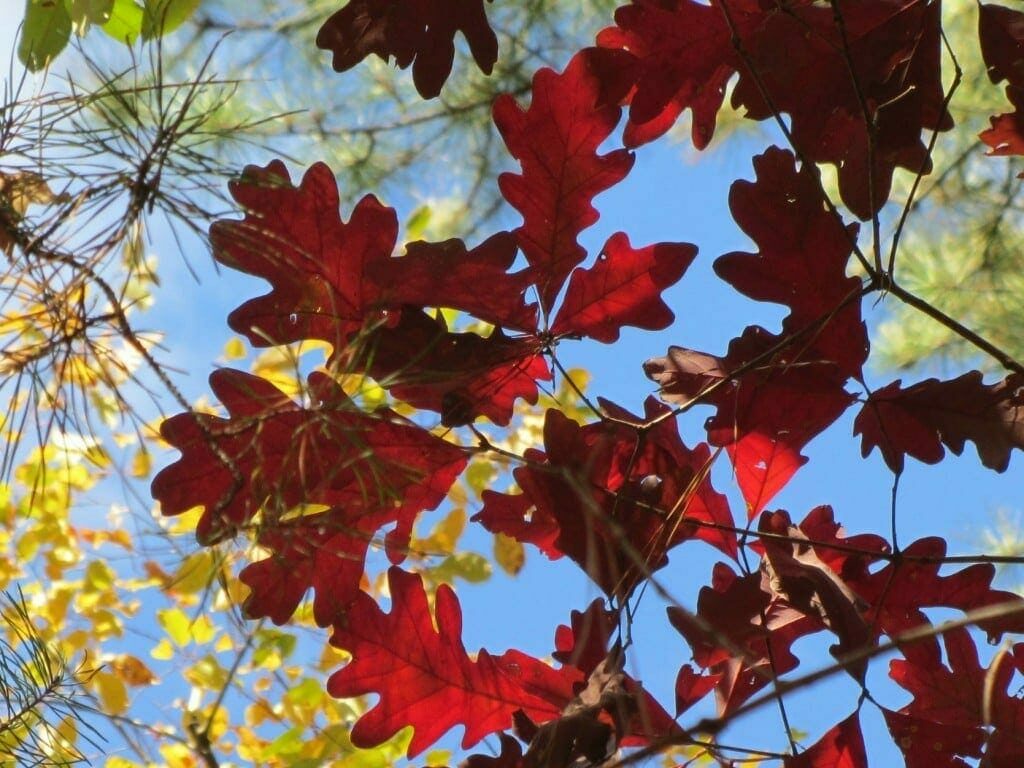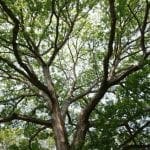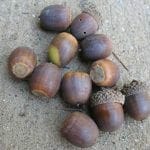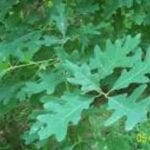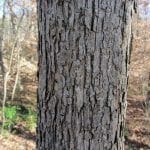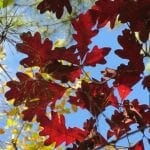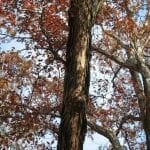- Habit
- Acorns
- Summer foliage
- Flaky bark
- Fall foliage
- Large specimen
The Georgia Native Plant Society is very pleased to announce the selection, by its enthusiastic members, of white oak (Quercus alba) as the Society’s 2009 Plant of the Year, the first canopy tree selected.
Quercus alba, the white oak, is one of the pre-eminent hardwoods of eastern North America. It is a long lived and majestic oak in the Beech family (Fagaceae) – some specimens are known to have lived over 600 years. White oaks can be found as far north as Quebec, throughout the state of Georgia and south to northern Florida and eastern Texas. While found naturally in moist, well-drained woodlands it is often found in cities since its deep roots rarely present problems to foundations and its strong branches hold up well to wind and ice.
The white oak grows wider than tall when not overcrowded and typically reaches 50 to 100 feet high, at higher altitudes it matures as a much shorter tree. Its canopy is more spreading than most other trees in closely packed mature forests or in open fields, where it can grow to epic sizes and have individual branches that extend 50 feet from the trunk!
Although called the white oak, the bark on its typically straight and single trunk is usually an ashen gray in color. A very distinguishing feature of this tree is that a little over half way up the tree the bark tends to become platy, meaning that it looks a little like overlapping scales that are easy to see and make this tree easy to identify. Some say that the bark of the white oak specimens can be as shaggy as a shag bark hickory! Every season brings out a quality that makes the white oak stand out in our southeastern forest. In the winter, its silver-ish flaking bark stands out amongst other trees so it is easy to identify.
The alternate leaves have a deep glossy green upper surface with a tint of blue and grow to between 5 and 8.5 inches long and 2.75-4.5 inches broad. In spring the young leaves are exquisite in their delicate silvery pink and covered with soft down. The petioles are short and the leaves, which cluster close to the ends of the shoots, are pale green and downy giving the entire tree a misty, frosty look.
The variably lobed leaves, sometimes shallow and sometimes deep lobed, may be somewhat branching or have lobes that extend less than half-way to the midrib. When full grown the leaves are thin, bright yellow green, shining or dull above and pale, glaucous or smooth below with yellow primary veins being very conspicuous. In late fall they turn a orange to deep red and drop although they sometimes remain on young trees through out the winter.
The bright yellow, pistillate flowers borne on short peduncles begin appear when the leaves are one-third grown around May. The annual acorns are sessile or stalked and begin falling in early October. These light brown, shiny 3/4 inch long acorns are a favorite winter staple for many birds, squirrels and deer.
The white oak like all oaks is extremely valuable to wildlife especially with the loss of the American chestnut; it provides food, shelter, nesting material – even the cavities that develop in these living and dead oak giants supply vital nesting sites for dozens of species of birds. Many people do not realize the diversity of insects that is supported by this magnificent tree. The insects supported by the white oak add to forest ecosystems providing more types of bird food and hosting myriad tiny moth species. Walkingsticks and katydids mature on oak foliage. The white oak is the only known food plant of theBucculatrix luteella and Buccalatrix ochrisuffusa caterpillars.
Planting stands of this one plant species would go a long way towards supporting the future of the nation’s biodiversity. Although it may be somewhat difficult to transplant once the tree is over a few feet tall, a white oak is easily grown from seed. Unlike red oak acorns, the white oak acorns germinate within a few days of falling from the tree. Although it produces a root, it does not send up a sprout until spring and so may be hidden in the leaves and humus. You can plant this sprouted acorn so prevalent here in Georgia and grow your own white oak.
Here in the USA white oak is the most important timber tree and possibly one of the most important hardwoods. Its tough and hard timber is used as lumber for beams, railroad ties, furniture, barrels and much much more. Because of its durability white oak has more uses in construction and other man-made objects than any other tree in the United States. The wood is extremely watertight and rot resistant, which is also why white oak was used to build the gun deck of the USS Constitution, “Old Ironsides”.
“If the Oak is the King of trees then the white oak is the King of Kings” – Donald Peattie. The favorite tree of many people who really know their trees, including Greg Levine, Program Director of Trees Atlanta, the beautiful white oak is clearly the perfect choice for GNPS Plant of the Year 2009.
Prepared by Jacqueline McRae & Paula Reith, co-chairs Plant of the Year Committee, for the Georgia Native Plant Society.
Scientific Name:
Common Name:
Scientific Name Pronounciation:
Plant Type:
Tree
Plant Hardiness Zones:
Plant Hardiness Zone(s):
Usual Size:
Flower:
Bloom Time Notes:
Leaf:
Fruit:
Wildlife:
Natural Habitat:
Propagation:
Bloom Time:
Sun or Shade:
Companion Plants:
Cultural Notes:

